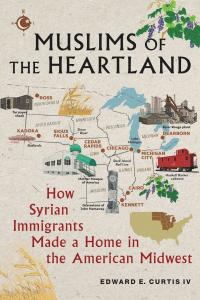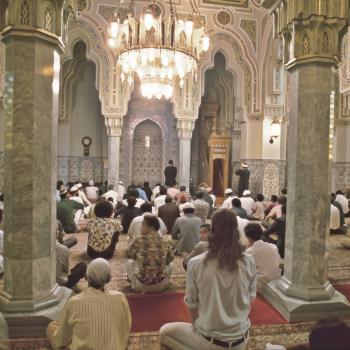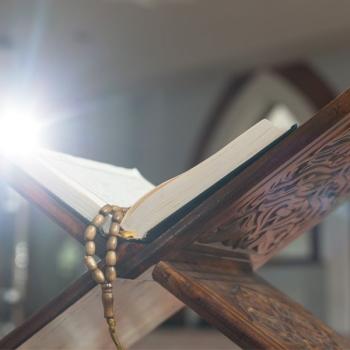 Syrian Muslims have long been a part of the mosaic of people in Midwest America. The stories and extensive records of their grit and determination to adapt and thrive in the Midwest are the sources for Edward E. Curtis IV’s splendid new book, Muslims of the Heartland: How Syrian Immigrants Made a Home in the American Midwest (New York University Press, 2022). A descendent of Syrian Midwesterners, Edward E. Curtis IV is the William M. and Gail M. Plater Chair of the Liberal Arts and Professor of Religious Studies at the Indiana University School of Liberal Arts at IUPUI.
Syrian Muslims have long been a part of the mosaic of people in Midwest America. The stories and extensive records of their grit and determination to adapt and thrive in the Midwest are the sources for Edward E. Curtis IV’s splendid new book, Muslims of the Heartland: How Syrian Immigrants Made a Home in the American Midwest (New York University Press, 2022). A descendent of Syrian Midwesterners, Edward E. Curtis IV is the William M. and Gail M. Plater Chair of the Liberal Arts and Professor of Religious Studies at the Indiana University School of Liberal Arts at IUPUI.
Curtis has a broad audience in mind and a specific aim for his new book. It is not meant to be a comprehensive history of all Syrians or Muslims in the Midwest. “This book,” he states, “tells the tales of only a few people and a few communities to bring the Syrian Muslim Midwest of the first half of the twentieth century to life.” Curtis also challenges “the bleaching of Midwestern history” to accurately reflect the rich diversity of the Midwest, past and present. “I grew up,” he says, “assuming that my brown skin was a foreign intervention in a white land. But my family’s history was far more typical than some would like to suggest. We Midwesterners are a more diverse, cosmopolitan bunch than many people outside our region suppose.”
Why did Syrian Muslims put down roots in the Midwest? Curtis states that “tens of thousands were attracted to the US Midwest, where the development of railroads and waterways linked the booming business of agriculture to heavy industry around the Great Lakes.” He points to the interconnectedness of the Midwest region: “The steam-powered locomotive and then the automobile was part of that story, but it was even more entangled than the means of transportation that connected them all. The Midwest’s growing towns, new factories, and new farms provided opportunities for Syrians in America to make a new home.”
Curtis gives wonderful glimpses into the lives of Syrian Muslims and their communities in towns and cities across the Midwest. His book is framed by a cornucopia of stories about love and loss, joy and sorrow, success and failure, and hope and despair. We meet builders, peddlers, merchants, veterans, entertainers, farmers, autoworkers, and wrestlers, whose lives were lifted in times of prosperity and damaged in times of hardship and uncertainty, such as during World War I, the Great Depression, and World War II. Syrian Muslims also had to defend themselves against episodes of nativism, xenophobia, Islamophobia, and discriminatory and racist immigration quota laws, especially the Johnson-Reed Act, passed by Congress as the Immigration Act of 1924.
In Detroit, which Curtis calls the “Capital of the Muslim Midwest,” Syrian Muslims did not isolate themselves; they built a strong and vibrant community based on openness to everyone. “Whether or not,” he writes, “someone lived in or visited Detroit, nearly everyone in the Syrian Muslim community across the Midwest had a connection to it; the city linked together with the networks of marriage, religious community, economic opportunity, and cultural activities around which Syrian Muslim life in the Midwest revolved.”
Curtis shows how Syrian Muslim Americans formed a triangle of identities (ethnicity, religion, citizenship) that worked in harmony. It’s the story of the United States. The conception of America as a “melting pot” is outdated and ethnocentric baggage from a bygone era. Americans do not have to shed their identities and offload or hide their treasured faith and heritage, customs, food, music, traditions, clothing, and languages to fit into America. “Syrians,” Curtis explains, “like Norwegians, Swedes, Germans, Poles, Bohemians, Jews, and many others, often publicly celebrated their ethnic and religious heritage as a way to participate in American life. Syrian ethnicity and Islamic religion became pathways to becoming American, and becoming an American were not necessarily seen as antithetical to maintaining one’s ethnic and religious ties to people outside the United States.”
Professor Edward E. Curtis IV deserves considerable praise for his fine work. His book is beautifully written, and it includes many historical photographs and lovely cover art by Scott Schiller and cover design by Adam B. Bohannon. Muslims of the Heartland is significant because it shines a bright light on Islamic history in a Midwest context. The Midwest is fertile ground for historians and other scholars to unearth and interpret vital stories of the past about our beloved multicultural heartland.
Joseph Richard Preville is a writer and book critic from Detroit, Michigan. He was a professor and writer in the Greater Middle East (Saudi Arabia, Oman, and Afghanistan) from 2005-2017. His work has appeared in The Christian Science Monitor, Harvard Divinity Bulletin, San Francisco Chronicle, The Jerusalem Post, Saudi Gazette, Muscat Daily, Informed Comment, and many other publications.












